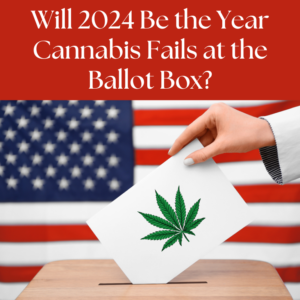Cannabis Markets Could Bring in $3 Billion in Year One

Upcoming Cannabis Legalization Votes Could Create $3 Billion in Revenue for Florida, North Dakota, and Nebraska
On Tuesday, voters in Florida, North Dakota, and Nebraska will have the opportunity to decide on various marijuana legalization measures that, if approved, could collectively generate $3 billion in revenue during the first full year of sales. Projections from the MJBiz Factbook suggest that by the fourth year, the combined revenue from these new markets could reach $4.3 billion. Here’s a breakdown of what each state’s marijuana market could look like and the factors influencing its potential growth.
Florida’s Amendment 3: A Potential Game-Changer
With a population of 22 million and an estimated 140 million annual visitors, Florida represents the largest potential adult-use marijuana market in this election. If Amendment 3 passes, Florida could see a first-year revenue of approximately $2.9 billion from recreational marijuana sales, placing it among the top cannabis markets in the United States alongside California and Michigan. This projection underscores Florida’s unique position as not only a populous state but also a tourist magnet, making it an attractive destination for cannabis businesses.
Existing Medical Cannabis Infrastructure
Florida already has a thriving medical marijuana program with over 883,000 registered patients, contributing approximately $2 billion annually in regulated sales. If the adult-use market launches successfully, Florida’s established cannabis infrastructure will be a key advantage, allowing the state to quickly accommodate an influx of adult-use customers. This infrastructure could help the state hit its projected $2.9 billion in sales during its first year and surpass $4.1 billion by the fourth year of operation.
Challenges to Implementation
Despite strong support in polls, there is uncertainty around when the adult-use market might launch. Although Amendment 3 would go into effect as early as May 2025, Florida’s Republican-controlled Legislature could impose regulations that delay implementation. Industry stakeholders hope that Florida lawmakers may follow Ohio’s recent example, allowing adult-use sales to commence even as they address regulatory details. If Amendment 3 passes and Florida swiftly establishes a regulated market, the state could become one of the largest cannabis markets in the nation, benefiting from both a large resident base and robust tourism.
Nebraska Initiatives 437 and 438: A Medical Cannabis Market
In Nebraska, voters will consider two separate initiatives related to medical marijuana after the state’s Supreme Court ruled in 2020 that a prior initiative violated the state’s single-subject rule. To address this issue, Nebraska cannabis advocates proposed two new measures: one allowing medical marijuana possession and use, and another establishing an agency to regulate the program. If both measures pass, Nebraska would join the majority of U.S. states in offering some form of legalized cannabis, giving 78% of the U.S. population access to medical marijuana.
Projected Revenue and Market Size
Nebraska’s medical marijuana market is expected to start modestly compared to larger states but could grow steadily. With a population of around 2 million, the state’s market could bring in roughly $50 million in sales in its first year, with potential to reach $102 million by the fourth year. Given that recent polls show 59% of Nebraskans support medical marijuana legalization, the market is expected to find stable demand among residents who may benefit from cannabis-based treatments.
Legal and Regulatory Considerations
While public support is high, Nebraska’s medical marijuana initiatives still face opposition, with some opponents turning to the courts for last-minute challenges. If legal challenges delay the rollout, Nebraska’s path to establishing a fully operational medical marijuana market could face hurdles. However, if the initiatives move forward without significant delays, Nebraska’s regulatory infrastructure could become a model for other states transitioning from prohibition to medical access.
North Dakota’s Initiated Measure 5: A New Adult-Use Market
For the third time since 2018, North Dakota voters will decide on legalizing recreational marijuana. While prior attempts at legalization have faced resistance, a successful vote for Initiated Measure 5 would make North Dakota one of the newer states to establish a regulated market for adult-use cannabis. This measure, if passed, could set up a system for adult-use marijuana sales by October 2025, following in the footsteps of other conservative states that have recently embraced recreational cannabis.
Market Projections and Influencing Factors
Despite its relatively small population, North Dakota could see significant revenue from recreational marijuana sales, with projections of $70 million in the first year and a potential rise to $115 million by the fourth year. North Dakota already has an active medical marijuana market, with nearly 10,000 patients who have been utilizing legal cannabis since 2019. The state’s medical marijuana sales reached $22.4 million in the fiscal year ending June 2024, a slight increase over previous years, showing steady demand that may extend to recreational users if the measure passes.
Sales Tax and Regulatory Implications
One potential factor influencing North Dakota’s marijuana market is the sales tax rate the state might apply to recreational marijuana. While Measure 5’s ballot information is based on an estimated 5% sales tax, future adjustments to this rate could impact overall revenue and pricing for consumers. North Dakota’s approach to taxation and regulation will play a significant role in shaping the accessibility and profitability of its adult-use cannabis market.
Potential Nationwide Impact if All Measures Pass
If Florida, North Dakota, and Nebraska voters approve their respective cannabis measures, a significant portion of the U.S. population would gain increased access to marijuana, either for medical or recreational purposes. Approval in Florida and North Dakota would mean that 60% of Americans could legally purchase recreational marijuana, while approval in Nebraska would bring 78% of the population under the umbrella of states offering medical marijuana. The expansion of regulated cannabis markets has economic, social, and medical implications, as more Americans gain legal access to cannabis products for various uses.
Competitive Positioning in the U.S. Cannabis Market
With Florida’s potential to generate billions in recreational sales, the state could soon rival California and Michigan as a top cannabis market, attracting significant attention from cannabis companies, investors, and entrepreneurs. North Dakota’s smaller but growing market and Nebraska’s medical marijuana program could also contribute to regional growth in the cannabis industry. The combination of new state markets is expected to stimulate local economies, create jobs, and generate tax revenue that could be used to fund public services and state programs.
Future Outlook for State-Level Cannabis Initiatives
The outcomes of these votes could further demonstrate the trend toward broader cannabis acceptance in the United States, with traditionally conservative states like North Dakota and Nebraska considering regulatory frameworks for marijuana use. As more states explore the potential economic benefits of legalizing cannabis, the next few years may see even more states introduce ballot measures or legislation focused on both medical and recreational marijuana. These developments point to an evolving landscape where state-level initiatives continue to shape the direction of the U.S. cannabis industry.
In summary, Tuesday’s votes could unlock billions in revenue across Florida, North Dakota, and Nebraska, underscoring the growing momentum for cannabis legalization in the United States. Each state’s unique market dynamics, regulatory environment, and economic potential will contribute to shaping the cannabis industry’s future in America.











